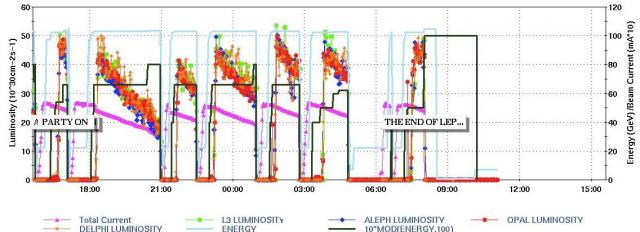Geneva, 8 November 2000. After extended consultation with the appropriate scientific committees, CERN1's Director-General Luciano Maiani announced today that the LEP accelerator had been switched off for the last time. LEP was scheduled to close at the end of September 2000 but tantalising signs of possible new physics led to LEP's run being extended until 2 November. At the end of this extra period, the four LEP experiments had produced a number of collisions compatible with the production of Higgs particles with a mass of around 115 GeV. These events were also compatible with other known processes. The new data was not sufficiently conclusive to justify running LEP in 2001, which would have inevitable impact on LHC construction and CERN's scientific programme. The CERN Management decided that the best policy for the Laboratory is to proceed full-speed ahead with the Large Hadron Collider (LHC) project.
Geneva, 8 November 2000. After extended consultation with the appropriate scientific committees, CERN1's Director-General Luciano Maiani announced today that the LEP accelerator had been switched off for the last time. LEP was scheduled to close at the end of September 2000 but tantalising signs of possible new physics led to LEP's run being extended until 2 November. At the end of this extra period, the four LEP experiments had produced a number of collisions compatible with the production of Higgs particles with a mass of around 115 GeV. These events were also compatible with other known processes. The new data was not sufficiently conclusive to justify running LEP in 2001, which would have inevitable impact on LHC construction and CERN's scientific programme. The CERN Management decided that the best policy for the Laboratory is to proceed full-speed ahead with the Large Hadron Collider (LHC) project.
CERN Council will be asked at its next December session to confirm the start of the dismantling of the LEP accelerator. The Director-General will also ask Council to strengthen the resources available for the LHC Project in order to accelerate the construction and installation programme of both the machine and the detectors.
For LEP's final year of running, CERN's accelerator physicists pulled out all the stops to push the accelerator's energy as high as possible and maximise the chances of a new discovery. Originally foreseen to produce electron-positron collisions at energies up to 200 GeV, LEP achieved a collision energy of 209 GeV this year giving experiments a final chance to explore unknown territory and to continue the hunt for the Higgs boson. This theoretical particle is related to the mechanism thought to be responsible for particle masses. Some particles are massless, while others have mass and the range of their masses is enormous. Why this is the case remains a mystery, but would be explained if Higgs bosons exist. Higgs bosons are generated by a field, the Higgs field, that is proposed to fill the whole of space. A particle's mass would be determined by the strength of its interaction with this field.
The LHC programme is the fastest and most effective way of observing new physics. Experiments at the new accelerator would be able to observe the Higgs boson in new and complementary ways, that will help reveal whether it accomplishes its anticipated task of giving masses to all other particles. Moreover, a Higgs boson weighing 115 GeV, the mass suggested by the LEP experiments, is expected to be accompanied by other new physics that should also be accessible to the LHC. One speculation is that there may also be a large number of new 'supersymmetric' particles, the lightest of which might constitute the dark matter in the Universe favoured by astrophysicists. If so, many species of these supersymmetric particle should be produced and detected at the LHC.
At the end of eleven years of running, LEP will be remembered as the machine that put the theory describing particle behaviour - the Standard Model - on solid ground. Precision measurements made by the four LEP experiments have confirmed the Standard Model to an extraordinary degree of precision. They have also demonstrated conclusively that three and only three families of matter particles exist. Why this should be the case remains another intriguing question for a new generation of researchers to address as we move into the LHC era and beyond.
1.CERN, the European Organization for Nuclear Research, has its headquarters in Geneva. At present, its Member States are Austria, Belgium, Bulgaria, the Czech Republic, Denmark, Finland, France, Germany, Greece, Hungary, Italy, Netherlands, Norway, Poland, Portugal, Slovakia, Spain, Sweden, Switzerland and the United Kingdom. Israel, Japan, the Russian Federation, the United States of America, Turkey, the European Commission and Unesco have observer status.

